This is Elven Town, from Shining Force II for the Sega Genesis. Here's the beginning of the original track:
It sounds kind of janky.
Computer, isolate the bass line and slow it down to 65%.
Yea, definitely some problem with that high note. The Sega Genesis sound chip (YM2612) has 6 FM channels; these bass notes are played on Channels 0, 1, and 5. As we will see, this bass line has a software-controlled vibrato, meaning that the channel frequency is modulated rapidly by the game's music engine, not using a built-in LFO of the YM2612 chip. And the music engine evidently has a small bug 🐞.
This music comes from a VGM file. The VGM format captures a stream of commands sent from the game to synthesizer chips. I ran vgm2txt from vgmtools library to convert the VGM stream to something readable and filtered the output for Channel 1 (good) and Channel 5 (corrupt). So the difference appears in these commands highlighted below:
The VGM text annotation tells us that these are frequency commands. Channel 1 has a slowly evolving values, and channel 5 has some noisy values in what would otherwise be smooth sequence. The "set LSB" byte values are plotted like this, to verify:
Now it's time to figure out how to repair those values. In order to repair them, we have to understand the VGM command stream for the YM2612 a little better.
From the right-hand side above (channel 5), all the commands we are interested in have this format:
53 A6 __ 53 A2 __
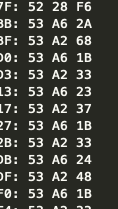
From various sources, we learn the following:
https://vgmrips.net/wiki/VGM_Specification
0x52 aa dd YM2612 port 0, write value dd to register aa 0x53 aa dd YM2612 port 1, write value dd to register aa
Cool. So what are registers $A6 and $A2? How do we interpret the value bytes?
https://blog.thea.codes/genesynth-part-2-basic-communication/
Port 0 = Key on/off and Channels 0,1,2 Port 1 = Channels 3,4,5 YM2612 assignments for registers $A0 onward: Channel High byte Low byte 0 / 3 $A4 $A0 1 / 4 $A5 $A1 2 / 5 $A6 $A2
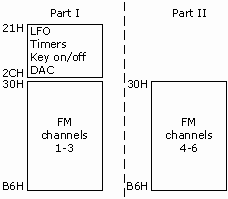
Part I = port 0, Part II = port 1
https://plutiedev.com/ym2612-registers#reg-A0
The register format is:
YM2612 registers $A4, $A5, $A6: frequency (high) Bit 7 Bit 6 Bit 5 Bit 4 Bit 3 Bit 2 Bit 1 Bit 0 0 0 BLK:2 BLK:1 BLK:0 FREQ:10 FREQ:9 FREQ:8 YM2612 registers $A0, $A1, $A2: frequency (low) Bit 7 Bit 6 Bit 5 Bit 4 Bit 3 Bit 2 Bit 1 Bit 0 FREQ:7 FREQ:6 FREQ:5 FREQ:4 FREQ:3 FREQ:2 FREQ:1 FREQ:0 FREQ: frequency BLK: block (octave)
…i.e. 2 unused bits, 3 octave bits, 11 frequency bits.
Now we are prepared to write some code that will interpret these pairs of "high" and "low" frequency commands, combine them together, and get the resulting frequency for channel 5.
const fs = require('fs');
const buf = fs.readFileSync('elven-town.vgm');
let i, j;
for (i = 256; i < buf.length; i++) {
// High byte
const [b0, b1, hi] = buf.subarray(i);
if (b0 === 0x53 && b1 === 0xA6) {
i += 2;
// High and low commands can be separated by some silence bytes (0x7n)
for (j = i; j < i + 6; j++) {
// Low byte
const [b3, b4, lo] = buf.subarray(j);
if (b3 === 0x53 && b4 === 0xA2) {
// Combine the bytes with bitwise operations
const baseFreq = ((hi & 7) << 8) | lo;
const oct = (hi >> 3) - 5;
const freq = baseFreq * Math.pow(2, oct);
console.log(freq);
}
}
}
}
Now we can see that the spurious frequencies are clearly separated from the normal vibrato stream; and we can make a simple condition to filter them out. We just reuse the previous value when we encounter one of these. Putting it all together:
const fs = require('fs');
const buf = fs.readFileSync('elven-town.vgm');
let lastHi = 0;
let lastLo = 0;
let lastFreq = 0;
let ctr = 0;
let i, j;
for (i = 256; i < buf.length; i++) {
// High byte
const [b0, b1, hi] = buf.subarray(i);
if (b0 === 0x53 && b1 === 0xA6) {
i += 2;
// High and low commands can be separated by some silence bytes (0x7n)
for (j = i; j < i + 6; j++) {
// Low byte
const [b3, b4, lo] = buf.subarray(j);
if (b3 === 0x53 && b4 === 0xA2) {
const baseFreq = ((hi & 7) << 8) | lo;
const oct = (hi >> 3) - 5;
const freq = baseFreq * Math.pow(2, oct);
// Filter out the bad frequencies
if (freq > 400 || (freq > 300 && (ctr < 2200 || ctr > 2800))) {
buf[i+2] = lastHi;
buf[j+2] = lastLo;
} else {
lastHi = hi;
lastLo = lo;
lastFreq = freq;
}
console.log(lastFreq);
ctr++;
}
}
}
}
fs.writeFileSync('elven-town-fixed.vgm', buf);
The result looks like this:
Computer, now resynthesize the bass line with the repaired vibrato command stream!!
We should be a little more curious about how these unintended frequency commands got there. There is some clear structure in the interference.
Let's take another look at the VGM command stream...
Here is what's happening. Every time there is a Key On command for Channel 3 or Channel 4, an unintentional frequency command is sent to Channel 5 immediately before. The bytes (highlighted in yellow and green) match the frequency intended for the Key On event. The commands outlined in red are mistakes. Now we can rewrite the script to surgically remove these errors:
let buf = fs.readFileSync(filename);
let patchCount = 0;
const lookback = 30;
for (let i = 0; i < buf.length - 2; i++) {
const [b0, b1, b2] = buf.subarray(i);
if (b0 === 0x52 && b1 === 0x28 && (b2 === 0xF4 || b2 === 0xF5)) {
for (let j = 3; j < lookback; j++) {
const idx = i - j;
const [n0, n1, n2] = buf.subarray(idx);
if (n0 === 0x53 && (n1 === 0xA6 || n1 === 0xA2)) {
patchCount++;
buf[i-j ] = 0x7F;
buf[i-j+1] = 0x7F;
buf[i-j+2] = 0x7F;
if (n1 === 0xA6) break;
}
}
}
}
I ran this script on the entire soundtrack since the error appears throughout. Listen to repaired Shining Force II on Chip Player or download the repaired VGM files here (originals included for comparison):
Bonus: this process repaired a song that was previously unplayable in Chip Player (29 - Zeon.vgz).
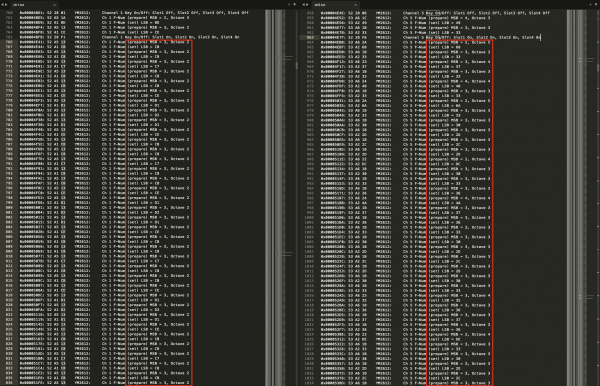
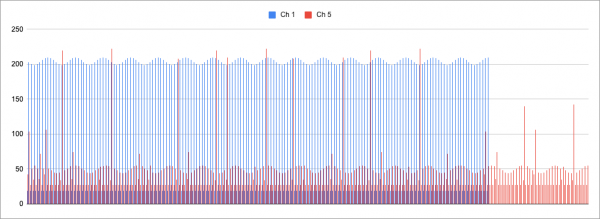
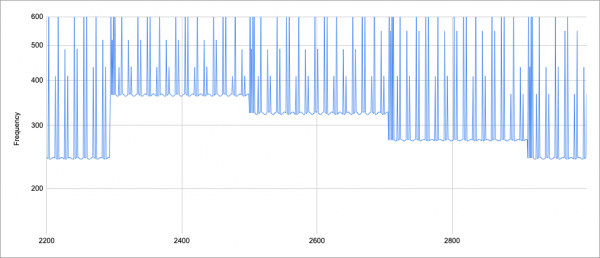
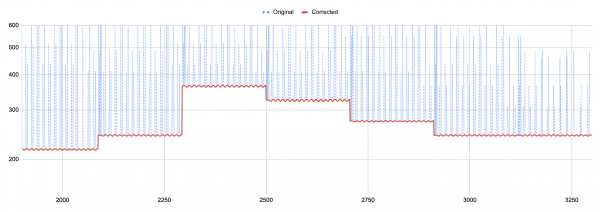
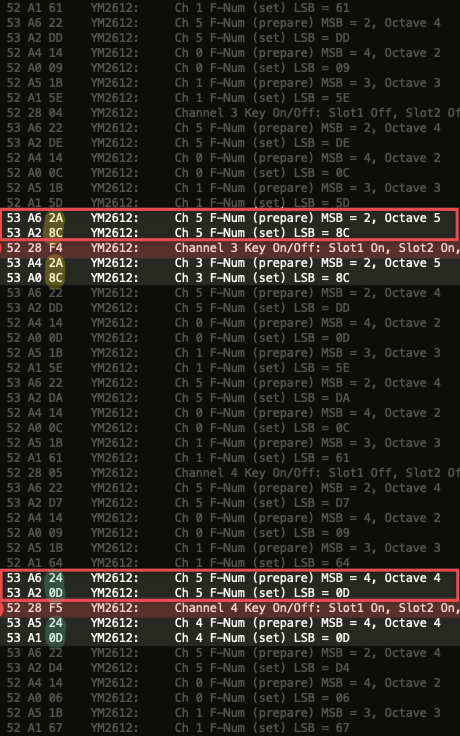
Nes
/ November 14, 2021 QuoteHello, I was trying to play the repaired songs and the program I'm using (VGM Player) crashes due to an unrecognized command when I try to play the "24 - Elven Town (fixed).vgz" file, both in the top folder and the "original" sub folder.
The error appears like this in the top level file:
Invalid VGM command 1C found! (filePos 0x00D7C)
Finish 1.93% 00:00.60 / 00:45.80 seconds
And like this in the sub folder file:
Invalid VGM command 1C found! (filePos 0x01D7C)
Finish 0.47% 00:00.54 / 00:45.80 seconds
The other "24 - Elven Town.vgz" files in both folders work fine in VGM Player, but the "fixed" files don't. If I unzip the .vgz files to .vgm, VGM Player still can't run them, but I can at least run them in VLC; it doesn't appear to have any issues with it.
Matt
/ December 12, 2021 QuoteThe file "24 - Elven Town (fixed).vgz" was a broken leftover, and I have removed it from the zip. Thanks!